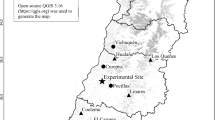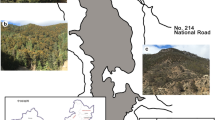Abstract
In the context of climatic changes, the adaptive potential of organisms toward new environmental challenges is becoming of central interest in modern ecology. Here we investigate the response of growth characteristics and survival in juveniles of four European provenances (Bulgaria, Germany, Hungary and Italy) of Quercus pubescens Willd. to extreme drought and warming in a full factorial common garden experiment. Our results show that extreme durations of drought exceed the tolerance of Quercus pubescens of all provenances. Plants of Italian provenance showed the highest capacity of whole-individual survival, and those of Bulgarian provenance showed the highest maintenance of the apex under extreme drought. Bud bank characteristics showed no general differences among provenances but responded to warming manipulations. The warming effect resulted in a reduction of collar buds and biomass. In Italian individuals it caused an increase of the apical budbank. This is suggestive of a better adaptation for height growth under warming. Our results imply that significant local adaptation of growth characteristics and survival occurs in Quercus pubescens. However, our findings do not support the idea that southern provenances are a general predictor of better plant performance.





Similar content being viewed by others
References
Albert CH, Thuiller W, Yoccoz NG, Douzet R, Aubert S, Lavorel S (2010) A multi-trait approach reveals the structure and the relative importance of intravs. Interspecific variability in plant traits. Funct Ecol 24:1192–1201
Arend M, Kuster T, Günthardt-Goerg MS, Dobbertin M (2011) Provenance-specific growth responses to drought and air warming in three European oak species (Quercus robur, Q. petraea and Q. pubescens). Tree Physiol 31:287–297
Balaguer L, Martínez-Ferri E, Valladares F, Pérez-Corona ME, Baquedano FJ, Castillo FJ, Marinque E (2001) Population divergence in the plasticity of the response of Quercus coccifera to the light environment. Funct Ecol 15:124–135
Bolte A, Ammer C, Löf M, Madsen P, Nabuurs G-J, Schall P, Spathelf P, Rock J (2009) Adaptive forest management in Central Europe: Climate change impacts, strategies and integrative concept. Scandinavian J Forest Res 24:473–482
Bond WJ, Midgley JJ (2001) The persistence niche: ecology of sprouting in woody plants. Trends Ecol Evol 16:45–51
Bretz F, Hothorn T, Westfall P (2010) Multiple comparisons using R. CRC Press, Boca Raton
Bruschi P (2010) Geographical variation in morphology of Quercus petraea (Matt.) Liebl. as related to drought stress. Pl Biosystems 144:298–307
Clarke PJ, Michael J, Lawes MJ, Midgley JJ (2010) Resprouting as a key functional trait in woody plants – challenges to developing new organizing principles. New Phytol 188:651–654
Crawley MJ (2009) The R Book. Wiley & Sons, Chichester
Damesin C, Rambal S (1995) Field-study of leaf photosynthetic performance by a Mediterranean deciduous oak tree (Quercus pubescens) during a severe summer drought. New Phytol 131:159–167
Davis SD, Ewers FW, Sperry JS, Portwood KA, Crocker MC, Adams GC (2002) Shoot dieback during prolonged drought in Ceanothus (Rhamnaceae) chaparral of California: a possible case of hydraulic failure. Amer J Bot 89:820–828
Del Tredici P (2001) Sprouting in temperate trees: a morphological and ecological review. Bot Rev 67:121–140
Easterling DR, Evans JL, Groisman PY, Karl TR, Kunkel KE, Ambenje P (2000) Observed variability and trends in extreme climate events: a brief review. Bulletin of American Meteorological Society 81:417–425
Ellenberg H (1996) Vegetation Mitteleuropas mit den Alpen, 5th edn. Eugen Ulmer Verlag, Stuttgart
Faraway J (2006) Extending the linear model with R. Chapman & Hall/CRC, Boca Raton, FL
Fox J (2002) An R and S-Plus companion to applied regression. Sage Publications, Inc., Thousand Oaks, California
Gandour M, Khouja ML, Toumi L, Triki S (2007) Morphological evaluation of cork oak (Quercus suber L.): Mediterranean provenance variability in Tunisia. Ann Forest Sci 64:549–555
Gratani L, Meneghini M, Pesoli P, Crescente MF (2003) Structural and functional plasticity of Quercus ilex seedlings of different provenances in Italy. Trees 17:515–521
Haldimann P, Gallé A, Feller U (2008) Impact of an exceptionally hot dry summer on photosynthetic traits in oak (Quercus pubescens) leaves. Tree Physiol 28:785–795
Hallé F, Oldeman RAA, Tomlinson PB (1978) Tropical trees and forests – an architectural analysis. Springer-Verlag, Berlin, Heidelberg, New York
Hijmans RJ, Cameron SE, Parra JL, Jones PG, Jarvis A (2005) Very high resolution interpolated climate surfaces for global land areas. Int J Climatol 25:1965–1978
IPCC (2012) Managing the risks of extreme events and disasters to advance climate change adaptation. A special report of working groups I and II of the intergovernmental panel on climate change. In Field CB, Barros V, Stocker TF, Qin D, Dokken DJ, Ebi KL, Mastrandrea MD, Mach KJ, Plattner G-K, Allen SK, Tignor M, Midgley PM (eds) Cambridge University Press, Cambridge and New York, NY, pp 582
Iwasa Y, Kubo T (1997) Optimal size of storage for recovery after unpredictable disturbances. Evol Ecol 11:41–65
Kabeya D, Sakai S (2005) The relative importance of carbohydrate and nitrogen for the resprouting ability of Quercus crispula seedlings. Ann Bot (Oxford) 96:479–488
Klimešová J, Klimeš L (2007) Bud banks and their role in vegetative regeneration – a literature review and proposal for simple classification and assessment. Percept Pl Ecol 8:115–129
Kölling C (2007) Klimahüllen für 27 Waldbaumarten. AFZ der Wald 62:1242–1245
Kreyling J, Bittner T, Jaeschke A, Jentsch A, Steinbauer MJ, Thiel D, Beierkuhnlein C (2011) Assisted colonization: a question of focal units and recipient localities. Restoration Ecol 19:433–440
Kreyling J, Thiel D, Nagy L, Jentsch A, Huber G, Konnert M, Beierkuhnlein C (2012) Late frost sensitivity of juvenile Fagus sylvatica L. differs between southern Germany and Bulgaria and depends on preceding air temperature. Eur J Forest Res 131:717–725
Kuster TM, Arend M, Bleuler P, Günthardt-Goerg MSR, Schulin R (2013) Water regime and growth of young oak stands subjected to air-warming and drought on two different forest soils in a model ecosystem experiment. Pl Biol 15(Suppl. 1):138–147
Langsrud Y (2003) ANOVA for unbalanced data: use Type II instead of Type III sums of squares. Statistics and Computing 13:163–167
Malanson GP, Trabaud L (1988) Vigour of post-fire resprouting by Quercus coccifera L. J Ecol 76:351–365
McDowell NG (2011) Mechanisms linking drought, hydraulics, carbon metabolism, and vegetation mortality. Pl Physiol 155:1051–1059
Meehl GA, Karl T, Easterling DR, Changnon S, Pielk Jr. R, Changnon D, Evans J, Groisman PY, Knutson TR, Kunkel KE, Mearns LO, Parmesan C, Pulwarty R, Root T, Sylves RT, Whetton P, Zwiers F (2000) An introduction to trends in extreme weather and climate events: observations, socioeconomic impacts, terrestrial ecological impacts, and model projections. Bull Amer Meteorol Soc 81:413–416
Meusel H, Jäger EJ, Rauschert S, Weinert E (1978) Vergleichende Chorologie der zentraleuropäischen Flora. Teil II. Gustav Fischer-Verlag, Jena
Min SK, Zhang X, Zwiers FW, Hegerl GC (2011) Human contribution to more-intense precipitation extremes. Nature 470:378–381
Nicotra AB, Atkin OK, Bonser SP, Davidson AM, Finnegan EJ, Mathesius U, Poot P, Purugganan MD, Richards CL, Valladares F, van Kleunen M (2010) Plant phenotypic plasticity in a changing climate. Trends Pl Sci 15:684–992
Petit RJ, Brewer S, Bordács S, Burg K, Cheddadi R, Coart E, Cottrell J, Csaikl UM, Dam B, Deans JD, Espinel S, Fineschi S, Finkeldey R, Glaz I, Goicoechea PG, Jensen JS, König AO, Lowe AJ, Madsen SF, Mátyás G, Munro RC, Popescu F, Slade D, Tabbener H, Vries SGM, Ziegenhagen B, Beaulieu JL, Kremer A (2002) Identification of refugia and post-glacial colonisation routes of European white oaks based on chloroplast DNA and fossil pollen evidence. Forest Ecol Managem 156:49–74
Quinn GP, Keough MJ (2002) Experimental design and data analysis for biologists. Cambridge University Press, Cambridge
R Development Core Team (2011) R: A language and environment for statistical computing. R Foundation for Statistical Computing, Vienna. Available at: http://www.R-project.org
Ramírez-Valiente JA, Sánchez D, Aranda I, Valladares F (2010) Phenotypic plasticity versus local adaptation for leaf ecophysiological traits in thirteen contrasting cork oak populations under varying water availabilities. Tree Physiol 30:618–627
Rauh W (1939) Über die Gesetzmässigkeit der Verzweigung und deren Bedeutung für die Wuchsformen der Pflanzen. Mitt Deutsch Dendrol Ges 52:86–111
Rose L, Leuschner C, Köckemann B, Buschmann H (2009) Are marginal beech (Fagus sylvatica L.) provenances a source for drought tolerant ecotypes? Eur J Forest Res 128:335–343
Sala A, Piper F, Hoch G (2010) Physiological mechanisms of drought-induced tree mortality are far from being resolved. New Phytol 186:274–281
Sayer U (2000) Die Ökologie der Flaumeiche (Quercus pubescens Willd.) und ihrer Hybriden auf Kalkstandorten an ihrer nördlichen Arealgrenze. Untersuchungen zu Boden, Klima und Vegetation. J. Cramer, Gebrüder Borntraeger Verlagsbuchhandlung, Berlin
Tutin TG, Heywood UH, Burges NA, Valentine DH, Walters SM, Webb DA (1964–1993) Flora Europaea. Vol. 1–5. Cambridge University Press, Cambridge
Vesk PA, Westoby M (2003) Drought damage and recovery – a conceptual model. New Phytol 160:7–14
Wellstein C, Spada F (2014) The status of Quercus pubescens Willd. in Europe. In Box EO, Fujiwara K (eds) Warm-temperate deciduous forests around the Northern Hemisphere. Geobotany Studies doi:10.1007/978-3-319-01261-2_8
Zimmermann MH (1978) Hydraulic architecture of some diffuseporous trees. Canad J Bot 56:2286–2295
Zimmermann MH (1983) Xylem structure and the ascent of sap. Springer-Verlag, NewYork
Acknowledgements
We thank C. Beierkuhnlein, J. Kreyling, D. Thiel and all members of the EVENT experiments at the University of Bayreuth, the team of the Ecological Botanical Garden (University of Bayreuth, DE), and G. Campetella (University of Camerino, IT) for their support. We appreciate the support of G. Huber and M. Konnert (Bavarian Institute for Forest Seeding and Planting (ASP), Teisendorf, DE), who cultivated our plants prior to the experiment. We are indebted to J. Klimešová (Institute of Botany, Třeboň, CZ), Petr Dostál and two anonymous reviewers whose critical comments and suggestions largely improved this contribution. We thank B. Reineking (University of Bayreuth, DE) for his advice on statistics and L. Mucina (University of Western Australia, AU) for correcting the English of the final version. The research was funded within the FORKAST project by the Bavarian State Ministry of Sciences, Research and the Arts.
Author information
Authors and Affiliations
Corresponding author
Electronic supplementary material
Below is the link to the electronic supplementary material.
ESM 1
(PDF 89 kb)
Rights and permissions
About this article
Cite this article
Wellstein, C., Cianfaglione, K. Impact of Extreme Drought and Warming on Survival and Growth Characteristics of Different Provenences of Juvenile Quercus pubescens Willd. Folia Geobot 49, 31–47 (2014). https://doi.org/10.1007/s12224-013-9186-9
Received:
Revised:
Accepted:
Published:
Issue Date:
DOI: https://doi.org/10.1007/s12224-013-9186-9




